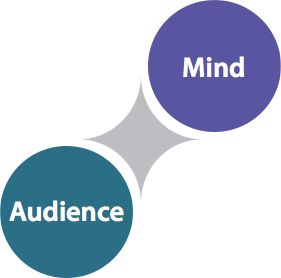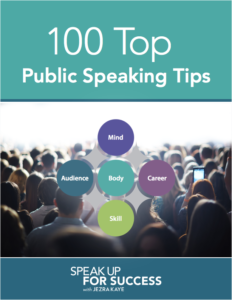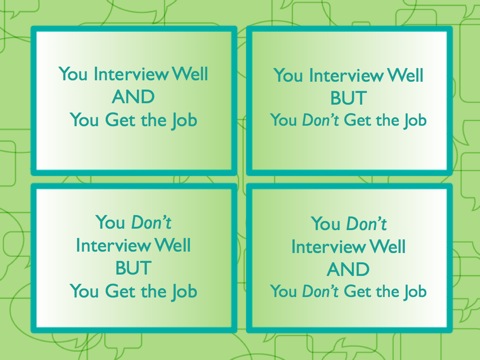 Communication is really important. (Well, obviously I think so, or I wouldn’t have devoted my adult life to it!)
Communication is really important. (Well, obviously I think so, or I wouldn’t have devoted my adult life to it!)
But it does have its limits. For instance,
You Can’t Make People Think Anything
Lots of my clients show up saying things like,
I want them to think I’m intelligent,
I have to impress people,
They need to understand my point.
This is asking for the moon, because you can’t control someone else’s thought process. You can do your best to sound intelligent, to deliver an impressive presentation, or to get your point across — but forget about making it happen, because nobody communicates that well!
Even if you speak “perfectly,” your listeners will choose their own reactions and form their own conclusions.
That’s a good thing to accept.
The Public Speaking Reality Grid
One of the best ways to appreciate the relationship between performance and outcome (“how you do” versus “what you get”) is to think about a job interview.
Every job interview is different, and the experience can be nuanced and complex.
But when you strip away all the specifics, there are really only four things that can happen:
Speeches are less binary than job interviews, which have only two possible outcomes, but the principle holds:
Sometimes there will be a clear correlation between your “performance” and how the audience reacts.
And sometimes there won’t be.
Let the Public Speaking Reality Grid Help You Relax
The newsflash that we can’t control other people’s reactions might seem discouraging on the surface. After all, why sweat and slave to produce a high-quality speech when there’s no guarantee that it will be well received?
But I find the reality grid strangely comforting.
The two “AND” options, in which the outcomes more or less aligns with your performance, are what we generally expect to happen:
- I was great! Success, reward, kisses, hugs!!
- Or: Boy, that sucked. The polite silence was deafening.
And the “BUT” option in which you do well but get a cool reception can also makes a certain cock-eyed sense if you tend to judge yourself harshly.
Which leave the fourth option — the one in which you get more than you feel you may have strictly “deserved.”
This can be unnerving for speakers who focus on their every flaw (and think the audience should do the same). But try to think of it this way:
Isn’t it great when people cut you some slack?
Why Audiences are More Forgiving than You Are
It constantly shocks people to realize that their audience is on their side. Our dark fantasies — or memories — of being judged and found wanting can sometimes feel so all-encompassing that we forget the audience isn’t really there to judge us.
At worst, they’re in those seats because they have to be.
At best, they’ve shown up to learn from or enjoy our talks.
But trust me, very few people go out of their way to sit in an auditorium and send the speaker bad vibes.
It’s just not fun to watch someone flailing around trying to make a point that you couldn’t care less about. They would much rather watch you succeed.
So the beauty and the promise of the Public Speaking Reality Grid is that it reminds us of one saving fact:
- Even though you can’t control the way your audience reacts…
- And even though you can’t (by definition) give a speech that’s perfect from beginning to end…
- And even though the world is often unfair, and outcomes are sometimes cruel…
- Your audience is very likely to give you the benefit of the doubt.
Hopefully, understanding this will make you feel better about giving up control.
And once you’re able to give up control and trust your practice and preparation…
You’re way more likely to succeed anyway!
 Buy 100 Top Public Speaking Tips: The Book!
Buy 100 Top Public Speaking Tips: The Book!
In 25 years of speaker coaching, I’ve helped my individual speaker coaching clients develop their strengths and skills to become authentic and effective communicators.
Along the way, I’ve developed tips for everything from small talk to speaking up in meetings, from managing fear to making an impact.
And now, I’ve shared it all in 100 Top Public Speaking Tips: The Book. This beautifully designed PDF booklet is searchable, clickable, and categorized, so that you can find what you need, instantly.


